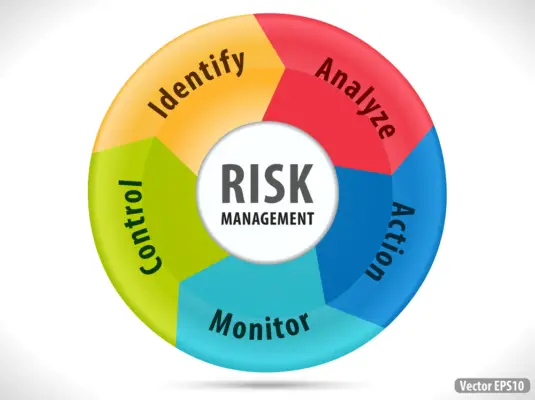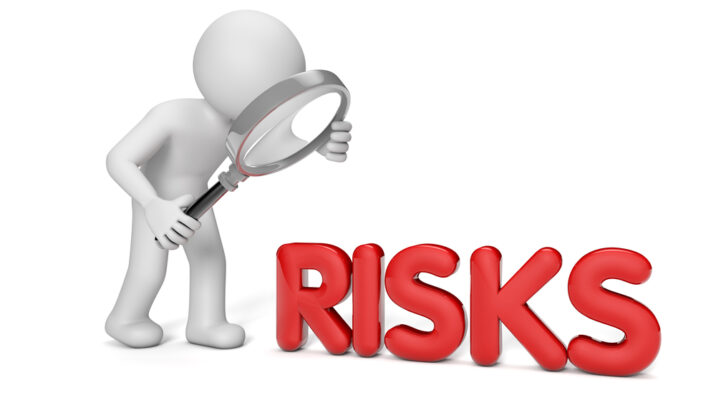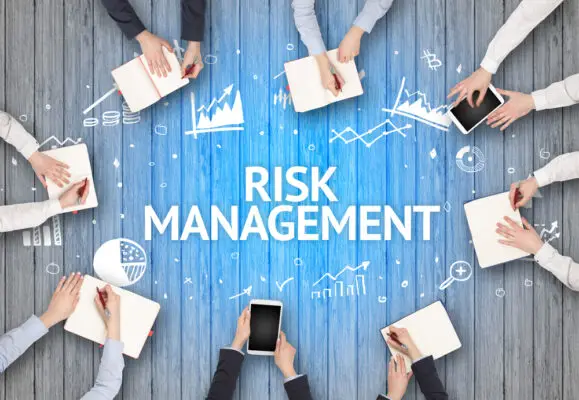Risk is an ever-present factor in our lives and organizations going concerns. Whether involved in business, healthcare, or even driving to work each day, potential hazards and threats can always hurt our organization’s goals and objectives. Identifying these risks is key to mitigating their effects and ensuring success.
To identify risks effectively, it is essential to understand what they are and how they manifest themselves.
Risks can be defined as the likelihood of an event hurting our desired outcome. This definition includes known hazards we regularly encounter, such as weather-related issues, machine malfunctions, and unforeseen threats that may arise unexpectedly.
To successfully manage risks, it is critical to identify them early so that appropriate measures can be taken to mitigate their effects.

Understanding the Definition of Risk
Understanding what constitutes a risk allows organizations to identify, assess and mitigate potential threats promptly and effectively.
Risk refers to the possibility of an event that will have negative consequences for an enterprise or project. Or according to ISO 31000:2018, Risk is the effect of uncertainty on objectives.
In a broad sense, risk refers to the possibility of an event that will impact the achievement of objectives. It can be positive (offering opportunities for benefit or gain) or negative (leading to loss or harm).
Risk is often characterized by reference to potential events (what might happen), the consequences (what the results might be), and the likelihood (how probable it is).
Risk generally refers to the uncertainty of financial or non-financial loss in business and management contexts.
Here are a few more specific definitions based on different contexts:
Financial Risk: This refers to the potential for loss arising from a company’s financial activities. It includes risks related to market movements, credit default, liquidity issues, and changes in interest or exchange rates.
Operational Risk: This is associated with the day-to-day activities of a company and involves risks arising from system failures, process inefficiencies, human errors, or external events impacting business operations.
Strategic Risk: This is related to the strategy of an organization. It involves risks that arise from making poor business decisions, not adapting to changes in the business environment, or not responding appropriately to competitive actions.
Legal & Compliance Risk: This refers to financial or reputational loss due to non-compliance with laws, regulations, standards, or ethical norms applicable to a business.
Environmental Risk: This involves potential losses due to environmental hazards such as natural disasters, climate change, or accidents causing pollution.
Reputational Risk: This relates to potential damage to the reputation of a business due to a particular event or action, which may result in financial loss or reduced trust among its stakeholders.
Risk management involves identifying, assessing, and prioritizing these risks, followed by coordinating and applying resources to minimize, monitor, and control the impact of these uncertain events.
Exploring examples of risks helps to illustrate their nature and impact on businesses. For instance, reputational damage is a common risk faced by organizations due to factors like bad publicity or social media backlash.
This could lead to a loss of customers and revenue, ultimately affecting the business’s overall performance. Another example is environmental risks which refer to the potential harm caused by natural disasters like floods or earthquakes. Such events can result in property damage, supply chain disruptions, and even loss of life.
Understanding the importance of identifying risks cannot be overstated, as it enables organizations to plan for potential crises proactively.
This helps minimize losses and enhances organizational resilience when facing adverse situations, thus ensuring the continuity of operations despite challenges encountered along the way.

Identifying Potential Hazards and Threats
Risk assessment techniques are vital in identifying potential hazards and threats as they provide an analytical framework for evaluating risks. Using risk identification methods, individuals can identify potential hazards and threats to a project or organization, assess their probability and impact, and develop strategies to mitigate them.
Some commonly used risk identification methods include:
- Brainstorming sessions with stakeholders
- Reviewing historical data from similar projects or situations
- Conducting surveys or interviews with subject matter experts
- Process mapping sessions to identify weaknesses in processes
- Using checklists to ensure all possible risks have been considered.
These methods help organizations identify internal (e.g., human error) and external (e.g., economic conditions) risks that could affect their operations. It is important to note that identifying risks is an ongoing process, as new risks may emerge over time.
Identifying potential hazards and threats is a crucial step in risk management as it allows organizations to proactively address issues before they become problems.
Organizations can identify potential risks early on in the planning phase. This helps them develop mitigation strategies that reduce the likelihood of incidents occurring while also minimizing their impact if they do occur.
Analyzing the Likelihood and Impact of Risks
Analyzes the likelihood and impact of potential hazards and threats. It provides a quantitative approach to evaluating risks, enabling organizations to allocate resources effectively and prioritize risk management efforts based on severity.
Probability assessment is the process of determining the likelihood of a risk occurring. This involves gathering data on past occurrences, considering external factors that may affect the probability of an event happening, and identifying any vulnerabilities in existing systems or processes.
Organizations can develop appropriate mitigation strategies by understanding the probability of a risk occurring.
Impact evaluation is another critical aspect of risk analysis. This involves assessing the potential consequences if a risk were to occur. Impact evaluation considers both direct and indirect effects, such as financial losses, damage to reputation, loss of customers or employees, and legal liabilities.
A thorough impact assessment will help organizations understand which risks pose the most significant threat to their operations and reputation.
Analyzing the likelihood and impact of risks is crucial for effective risk management. Probability assessment helps organizations prioritize resources by focusing on high-probability risks that could cause significant harm if left unaddressed.
Impact evaluation provides insight into how severe those consequences might be if a particular hazard or threat materializes. That is L* I( Likelihood* Impact)
Developing Risk Management Strategies
Risk assessment techniques are crucial in identifying, analyzing, and prioritizing risks based on their likelihood of occurrence and impact on an organization’s objectives.
These techniques may include brainstorming sessions, SWOT analysis, surveys, interviews, checklists, or scenario planning.
Once risks are identified and assessed, organizations must develop appropriate risk communication strategies that help them disseminate information about potential risks to relevant stakeholders.
Effective communication helps ensure that all parties understand the nature of the risks and can take steps to mitigate or manage them.
Communication strategies may include holding meetings with stakeholders such as employees or customers, publishing reports outlining potential hazards, or providing training programs that teach individuals how to respond in emergencies.
Developing effective risk management strategies involves a comprehensive approach that considers various factors, including assessing potential risks using SWOT analysis or scenario planning techniques.
Developing effective risk communication strategies that allow for transparent dissemination of information among relevant stakeholders; and implementing measures designed to prevent or mitigate actual risks.
Implementing Risk Mitigation Plans
This requires a proactive and multifaceted approach that involves analyzing potential threats, assessing their impact on organizational goals, and deploying appropriate measures to reduce the likelihood of occurrence or minimize their consequences.
To ensure that these plans are effective, organizations must consider the following:
Effective communication:
The success of any risk mitigation plan depends heavily on open and effective communication among all stakeholders involved in its implementation. This includes employees at all levels, vendors, shareholders, customers, and regulatory bodies.
Clear and concise messaging about the risks being addressed, the steps being taken to mitigate them, and everyone’s roles and responsibilities can help avoid misunderstandings or confusion down the line.
Resource allocation:
A risk mitigation plan requires time, money, personnel, equipment, and technology. Organizations must allocate these resources wisely to maximize their effectiveness while minimizing costs.
This involves prioritizing risks based on their severity and likelihood of occurrence so that resources are focused where they are most needed.
Regular monitoring:
Risk management is not a one-time event but an ongoing process requiring regular monitoring to ensure continued effectiveness. Organizations should establish clear metrics for measuring progress toward achieving risk mitigation goals and regularly review them with relevant stakeholders.
Continuous improvement:
Finally, implementing risk mitigation plans should be viewed as an opportunity for continuous improvement rather than a one-off exercise. Organizations should learn from past experiences by conducting post-implementation reviews to identify areas where improvements can be made in future iterations of their plans.
Implementing risk mitigation plans is crucial for organizations looking to safeguard against potential threats that may jeopardize their mission-critical objectives.

Frequently Asked Questions
How do I prioritize risks once they have been identified?
Risk assessment is crucial in identifying potential hazards that may affect an organization. However, evaluating the likelihood and impact of each identified risk is equally important to determine which risks should be addressed first.
This process can be achieved by using a risk matrix, which plots the severity and probability of each risk on a grid. Organizations can prioritize their risks by analyzing these factors and developing mitigation strategies accordingly.
The higher the likelihood and impact of a particular risk, the more urgent it becomes for an organization to address it.
Who should be involved in the risk management process?
Stakeholder engagement is a crucial aspect of the risk management process. It involves identifying, analyzing, and engaging with relevant stakeholders who potential risks may impact.
These stakeholders could include employees, customers, suppliers, regulators, and other parties interested in the organization.
Organizations can gather critical insights and perspectives through stakeholder engagement to inform their decision-making process.
Effective stakeholder engagement is critical for ensuring that all relevant perspectives are considered when deciding how to manage risks within an organization.
How do I ensure that my risk management strategies are effective?
Tracking progress is essential in determining whether or not the risk management plan is effective.
This involves conducting regular reviews and evaluations of the risk assessment techniques used and monitoring any changes in risk factors.
A risk management plan must be tailored to specific risks and constantly updated with new information to ensure that it is effective.
Risk mitigation strategies should also be tested to gauge their effectiveness in mitigating potential risks.
Organizations can identify areas where improvements are needed by tracking progress and adjusting their plans accordingly.
What are some common mistakes to avoid during the risk management process?
One such mistake is the failure to consider all possible risks. Organizations may focus on obvious risks and overlook less apparent ones, leading to potential problems.
Another mistake is relying solely on past experiences to inform risk identification rather than considering new or emerging risks that may not have been encountered before.
Additionally, inadequate communication and collaboration among team members can lead to incomplete or inaccurate risk assessments.
To avoid these mistakes, organizations should take a comprehensive approach to risk identification, incorporate diverse perspectives and expertise, and prioritize ongoing communication and collaboration throughout the risk management process.
How do I monitor and evaluate the success of my risk mitigation plans?
To ensure the success of risk mitigation plans, tracking progress and adjusting plans as needed is essential.
Effective tracking involves setting clear objectives and developing a monitoring system that collects data on progress towards those objectives.
This can include regular reporting, performance metrics, and feedback from stakeholders.
Adjusting plans may involve modifying strategies or tactics based on new information or changing circumstances, such as unforeseen risks or shifting priorities.
It is important to have a flexible approach to ongoing evaluation and adaptation of risk mitigation plans to ensure their continued effectiveness in managing potential risks.

Conclusion
Identifying risks is crucial to any successful business or project. Organizations can analyze the likelihood and impact of these risks by understanding the definition of risk and recognizing potential hazards and threats.
This analysis enables them to develop effective risk management strategies and implement mitigation plans that minimize the chances of negative outcomes.
On the one hand, failing to identify risks can lead to significant financial losses, legal issues, reputational damage, or even physical harm to employees or stakeholders.
On the other hand, proactive risk identification and management can enhance organizational resilience and increase stakeholder confidence in an organization’s ability to navigate challenges successfully.
Therefore, it is essential for individuals responsible for managing risks within an organization to prioritize this process continually. In doing so, they ensure that their organizations are well-positioned to achieve their goals while minimizing potential negative impacts on stakeholders.

Chris Ekai is a Risk Management expert with over 10 years of experience in the field. He has a Master’s(MSc) degree in Risk Management from University of Portsmouth and is a CPA and Finance professional. He currently works as a Content Manager at Risk Publishing, writing about Enterprise Risk Management, Business Continuity Management and Project Management.

